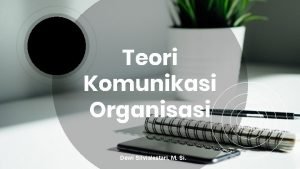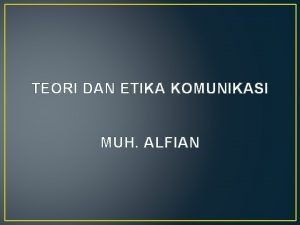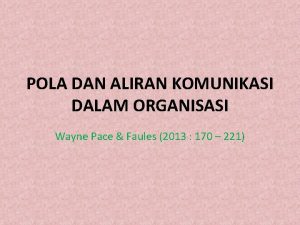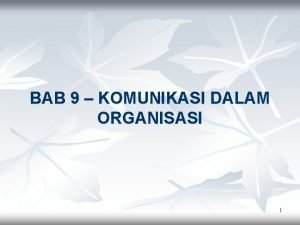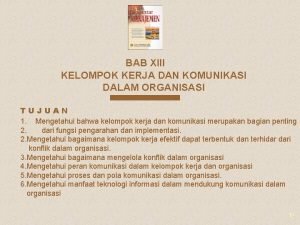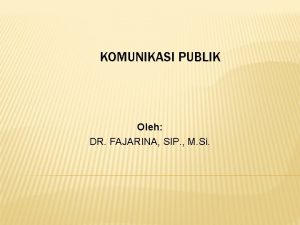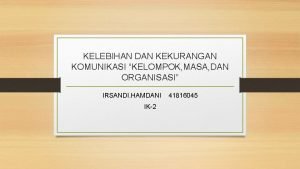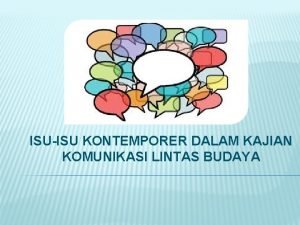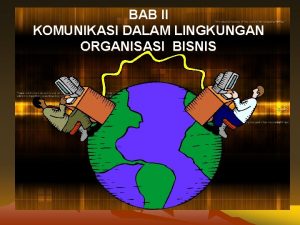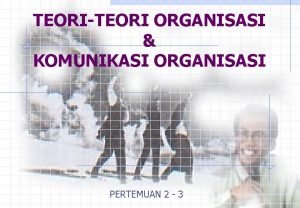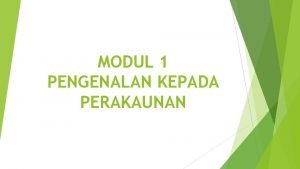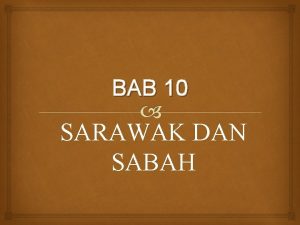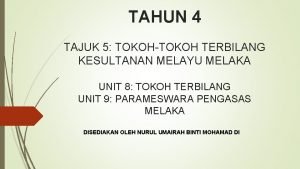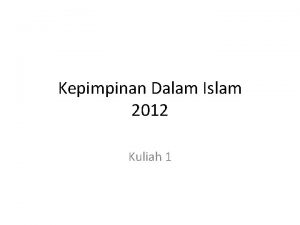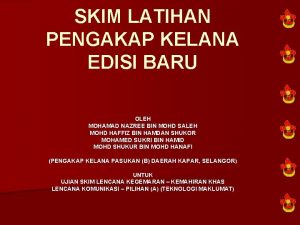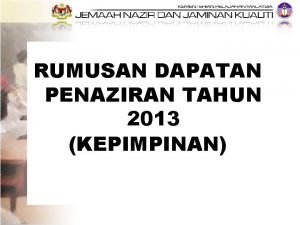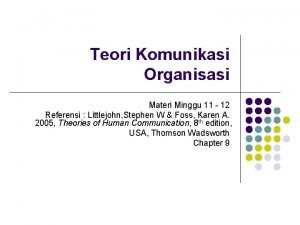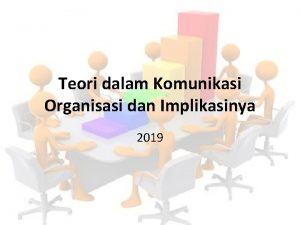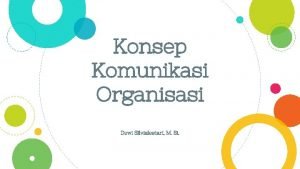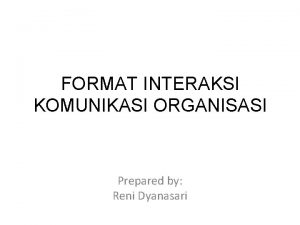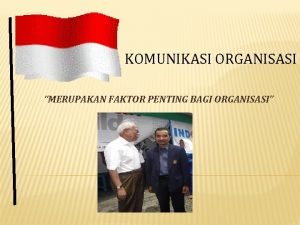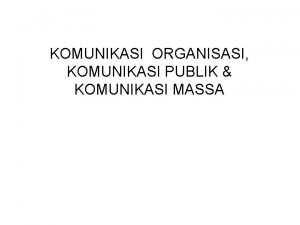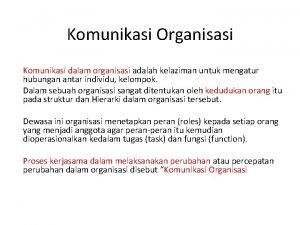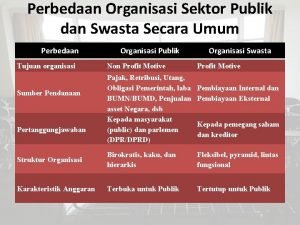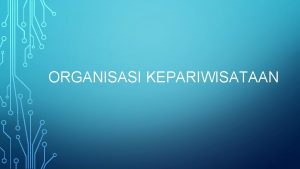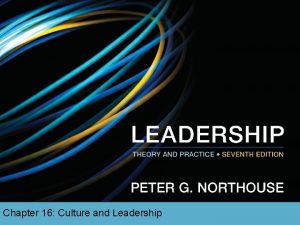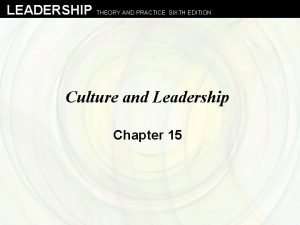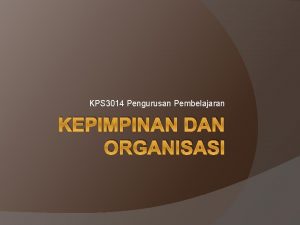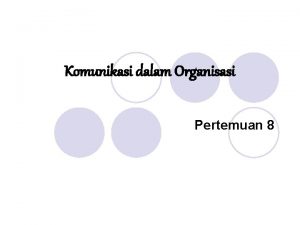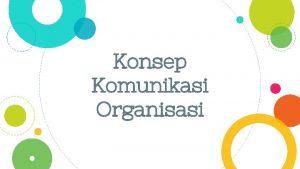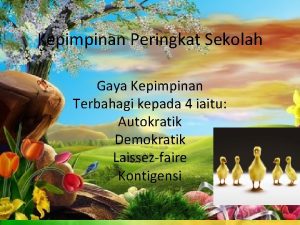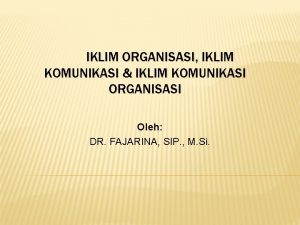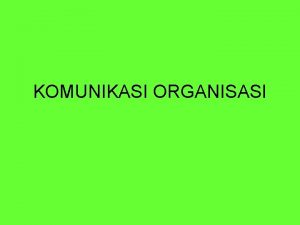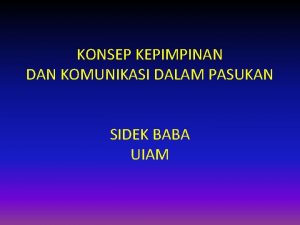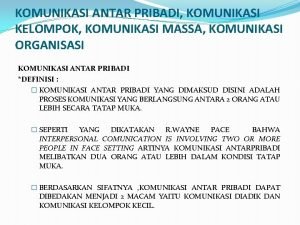KEPIMPINAN KOMUNIKASI DALAM ORGANISASI Work Culture 1 Leadership






































- Slides: 38

KEPIMPINAN & KOMUNIKASI DALAM ORGANISASI

Work Culture 1. Leadership skills 1. Entitlementality 2. Introvert to open Networking - technical competence 3. High value added staff - people competence 4. Global mind set - conceptual skills 5. Contemporary and - judgment skills forward thinking Attitude - a believer in change Leadership 2. and followership in balance Work Culture Values and ethics 1. Personal values 2. Customer related values 3. Leadership values 4. Professional values 5. Religious values Approach to work Managership, leadership 3. Entrepreneurial stance 4. Identity and image 5. Management of change 1. Mindset – customer oriented 2. Mindset – Quality oriented 3. Mindset – continuous improvement 4. Teamwork 5. Technology conscious 6. Result focused 7. Domestically focused to globally focused 8. Goals

A New Model For 21 st Century Organization From Earlier paradigm To Current & Future Paradigm v Being a manager Being a leader v Being a boss Being a coach/ facilitator v Controlling people Empowering people v Centralizing authority Distributing leadership v Micro-managing Aligning w/ vision/ strategy v Directing w/ rules/ regulat. Guide w/ values/culture

The New Reality for the Organization OLD Paradigm NEW Paradigm • Stability • Change/crisis mgt. • Control • Empowerment • Competition • Collaboration • Uniformity • Diversity • Self-centered • Higher ethical purpose • Hero • Humble

Leadership Challenges q Globalization q Corporate Functions q Customer Oriented Strategy q Optimum Use of Technology q Quality Management q Administration verses Management q Changing Management Mindset

Critical Success Factors q q q Market Driven Programs Innovative Delivery System Optimum Use of Technology Identity and Image Quality Consideration Strong Administrative / Management Support

Who is a Leader ? • Determinant for organization success • Agent of people changes

Effective and Ineffective leaders Most effective leader Delegates Knows the job Intelligent Consistent in giving directions Treats staff with respect Trains staff Handles conflict well Motivates staff Gets high performance on the job Decisive Organized – plans well Fair Responsive to staff requests A good communicator Sense of humor Personally “turned on” to the job – excited about job Never puts staff down in public Least effective leader Seldom seen in office Not very intelligent Won’t make decision Sees himself as superior Doesn’t communicate Has personal favorites among staff Inconsistent Treats staff with contempt Makes all important decisions on his own Unorganized Doesn’t motivate staff

WHAT EFFECTIVE LEADERS DO • Communicate Well – Communicate clearly, in a timely fashion, and that they keep the people they lead informed. • Listen – Good recording skills, ability to listen empathically.

WHAT EFFECTIVE LEADERS DO • Demonstrate approachability – It related to leader’s need for information. • Delegate effectively – Truly essential activities, requires communication, start to finish.

WHAT EFFECTIVE LEADERS DO • Lead by example – To perceive that a leader has or has not “walked the talk” is basically communication. • Read situations and people well – Sizing up the situational and/or personal factors that have important bearings on leadership needs and possibilities, good at detecting the relevant contingencies.

WHAT EFFECTIVE LEADERS DO • Use a variety of power bases to lead – Managers have power to lead, posses and use a broad range of power bases, depending on situations and people. • Teach well – Good leaders are good teachers. It’s part of developing people. • Care about the people they lead-and show it – Know that “anything can be a

WHAT EFFECTIVE LEADERS DO • Treat people fairly, honestly and consistently – Not playing favorites among those they lead, no “sugar coating” in all matters, and consistency of words and deeds characterize the manner of effective leaders.

WHAT EFFECTIVE LEADERS DO • Criticize and Accept criticism effectively a) Criticizing effectively meant being able to criticize constructively, without provoking defensiveness. b) Accept criticism effectively meant the ability to both “listen” to dissenters and take direct criticism without “keeping score” or exacting retribution. (Adapted from Axley (1990))

An effective leader is one who can make ordinary People Do extraordinary things, make common people do uncommon Things, Leadership is a lifting of man’s sights to a higher vision, the raising of man’s standard to a higher performance, the Building of a man’s performance beyond its normal limitations Peter Drucker

DEFINITION OF LEADERSHIP “ Leadership is the ability of a individual to influence, motivate, and enable others to contribute toward the effectiveness and success of the organization” House et al. , 1999

“Leadership is a process whereby an individual influences a group of individuals to achieve a common goal”. (Northouse, 2004) “Leadership is the influencing process of leaders and followers to achieve organizational objectives through changes”. (Lussier & Achua, 2004) “Leadership is a process of giving purpose (meaningful direction) to collective effort, and causing willing effort to be expended to achieve purpose” (Jacobs & Jacques, 1990)

What is Leadership? • A process of social influence to move individual and groups toward goal achievement. • Sharing a vision and engaging followers in that vision. • The ability to move an organization to a higher level of performance by transforming vision into significant actions. • A relationship, as opposed to the property of an individual. • An observable, learnable, set of practices and skills. • An integration of theory, process, and practice.

Leadership is a Process • Leadership involves influences • Leadership occurs in groups • Leadership is a passionate mindset towards objectives • Leadership is an influence process that assists groups of individuals toward goal attainment.

Six Leadership Styles Coercive: Intent on obtaining immediate compliance. Authoritative: Intent on mobilizing people toward a vision. Clearly states direction and actions. Affiliative: Intent on promoting harmony, cooperation, and good feelings amongst workforce. Democratic: Intent on building group consensus and commitment through group decision-making. Pacesetting: Intent on setting high performance standards; models standards. Coaching: Intent on developing people for future performance.

HALANGAN KOMUNIKASI

• The know – it – all - Tidak suka diberi pandangan atau pendapat baru

• The manipulator - Pandai mengambil kesempatan daripada kerja orang lain untuk dapatkan nama dan pujian

• The prima – Donna - Ingin bertindak sebagai perantara pekerja dengan Ketua Jabatan

• The Overseer - Hanya pandai memberikan arahan tanpa bersama-sama mengambil bahagian dalam melaksanakan tugas.

• The Martyr - Menganggap dirinya sebagai Pejuang (bukan keagamaan) mungkin bekerja kuat tetapi untuk tujuan mendapatkan pengiktirafan.

• The Gossip - Menghabiskan banyak masa dengan membesar-besarkan cerita berkenaan pekerja lain.

• The Backstabber - Kawan Makan Kawan

KOMPENTENSI

KOMPETENSI PERSONAL

KESEDARAN DIRI (SELF AWARENESS) • Kesedaran Emosi Diri: membaca emosi diri sendiri dan mengetahui implikasinya: menggunakan rasa keberanian untuk mengarah keputusan. • Mengetahui kekuatan dan keterbatasan diri • Percaya diri: menyedari nilai dan kemampuan diri yang baik.

PENGURUSAN DIRI • Pengendalian emosi diri: mampu mengendalikan keinginan dan emosi. • Tranparensi: menunjukkan kejujuran, integriti dan dapat dipercayai. • Adaptasi: dapat mengatasi keadaan yang berbeda dan menyelesaikan rintangan yang ada. • Pencapaian: dorongan untuk memperbaiki prestasi untuk memenuhi standard yang terbaik. • Inisiatif @ persiapan mengambil peluang. • Optimis: melihat aspek positif

KOMPETENSI SOSIAL

KESEDARAN SOSIAL • Empati: merasakan emosi orang lain, mengerti perpekstif mereka • Kesedaran organisasi: membaca arus dan jaringan keputusan organisasi. • Layanan: mengenal dan memenuhi kehendak pelanggan.

PENGURUSAN PERHUBUNGAN (Relationship Management) • Kepemimpinan inspirasi: mengarahkan dan memotivasi dengan visi yang tegas. • Pengaruh: menggunakan sejumlah tektik untuk memujuk. • Mengembangkan orang lain: mengembangkan kemampuan orang lain melalui maklum balas dan petunjuk. • Penggerak perubahan: berinisiatif dan memimpin dengan arah yang baru.

PENGURUSAN PERHUBUNGAN (Relationship Management) • Pengurusan konflik: memecahkan perselisihan • Membangun hubungan: mencipta dan memelihara hubungan dengan orang ramai. • Kerjasama kelompok: membangunkan kelompok dan kerjasama.

Leader and manager • Managers administer, leaders innovate • Managers ask how and when, leaders ask what and why • Managers focus on systems, leaders focus on people • Managers do things right, leaders do the right things • Managers maintain, leaders develop • Managers rely on control, leaders inspire trust • Managers have a short-term perspective, leaders have a longer-term perspective • Managers accept the status-quo, leaders challenge the status-quo • Managers have an eye on the bottom line, leaders have an eye on the horizon • Managers imitate, leaders originate • Managers emulate the classic good soldier, leaders are their own person • Managers copy, leaders show originality

SEKIAN TERIMA KASIH
 Organisasi dan kepimpinan sekolah
Organisasi dan kepimpinan sekolah Kepimpinan dan organisasi
Kepimpinan dan organisasi Pendekatan klasik dalam komunikasi organisasi
Pendekatan klasik dalam komunikasi organisasi Etika dalam komunikasi organisasi
Etika dalam komunikasi organisasi Contoh aliran komunikasi dalam organisasi
Contoh aliran komunikasi dalam organisasi Komunikasi mendatar
Komunikasi mendatar Model kelompok kerja yang efektif
Model kelompok kerja yang efektif Tipe komunikasi publik dalam organisasi
Tipe komunikasi publik dalam organisasi Bentuk komunikasi dalam organisasi
Bentuk komunikasi dalam organisasi Jelaskan kelebihan dan kekurangan komunikasi kelompok
Jelaskan kelebihan dan kekurangan komunikasi kelompok Contoh isu komunikasi
Contoh isu komunikasi Komunikasi dalam lingkungan organisasi bisnis
Komunikasi dalam lingkungan organisasi bisnis Teori peniti penyambung
Teori peniti penyambung Ciri akauntan sebagai pemimpin
Ciri akauntan sebagai pemimpin Ciri ciri seorang ketua suku sarawak
Ciri ciri seorang ketua suku sarawak Tugas penghulu bendahari
Tugas penghulu bendahari Maksud autokratik
Maksud autokratik Perbezaan pemimpin formal dan tidak formal
Perbezaan pemimpin formal dan tidak formal Ciri kepimpinan uthman bin affan
Ciri kepimpinan uthman bin affan Kedudukan lencana pengakap kelana
Kedudukan lencana pengakap kelana Kepimpinan instruksional
Kepimpinan instruksional Perspektif klasik komunikasi organisasi
Perspektif klasik komunikasi organisasi Teori struktural klasik komunikasi organisasi
Teori struktural klasik komunikasi organisasi 7 konsep kunci komunikasi organisasi goldhaber
7 konsep kunci komunikasi organisasi goldhaber Format interaksi komunikasi organisasi
Format interaksi komunikasi organisasi Faktor komunikasi organisasi
Faktor komunikasi organisasi Dimensi komunikasi organisasi
Dimensi komunikasi organisasi Dimensi komunikasi organisasi
Dimensi komunikasi organisasi Hubungan posisional adalah
Hubungan posisional adalah 7 konsep kunci komunikasi organisasi
7 konsep kunci komunikasi organisasi Komunikasi organisasi adalah
Komunikasi organisasi adalah Perbedaan organisasi publik dan bisnis
Perbedaan organisasi publik dan bisnis Pada dasarnya organisasi
Pada dasarnya organisasi Transformational leader and transactional leader
Transformational leader and transactional leader Adaptive leadership style
Adaptive leadership style Situational leadership vs adaptive leadership
Situational leadership vs adaptive leadership Culture and leadership northouse
Culture and leadership northouse Leadership across culture
Leadership across culture Culture and leadership northouse
Culture and leadership northouse


